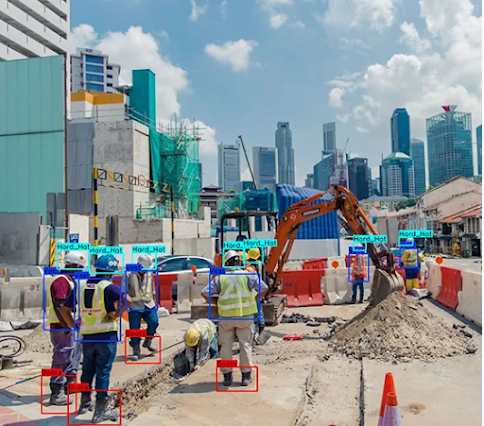Reader Response Draft 3: Real-Time PPE Detection with Computer Vision and AI
The
article “Transforming Workplace Safety: Harnessing AI for Real-Time PPE
Monitoring” explores the impact of Personal Protective Equipment (PPE)
detection by AI and several advantages of the use of AI to deal with
non-compliance of not wearing PPE (Rebecca, L. n.d).
The
technology, empowered with AI-enabled image and video analysis can identify
various personal protective equipment and promptly send alerts regarding individuals
lacking proper Personal Protective Equipment (PPE) or not wearing it correctly.
(Lambert, R. n.d). Based on one of the few companies that supply this
technology, the technology offers construction site monitoring and provides
centralized oversight to managers through a user-friendly platform by sending
real-time safety alerts for PPE non-compliance. It also provides workplace
recordings to obtain video data on workplace safety and potential hazards for
identifying and preventing accidents (V3 Smart Technologies, 2024). The technology
works by obtaining red-green-blue (RGB) images from CCTV, which are transmitted
through a monitoring system responsible for ‘detection and verification’ and ID
association and consequently, sending off alarms regarding non-compliant
workers (Torres et al., 2021).
In my
research for a recent civil engineering innovation in construction industry, a real-time
PPE detection with computer vision and AI stands out the most as it boosts the
productivity of managers and enhances the safety of construction workers. Even
though it may seem beneficial to use the technology in construction sites, it
is also worth considering a limitation that it poses for a better understanding
of how reliable this technology is for construction use.
The adoption of a real-time PPE detection with
computer vision and AI offers a notable benefit by boosting the productivity
for managers through the elimination of manual detection (Rebecca, L. n.d).
AI-driven PPE detection seamlessly complements managerial efforts through a remote
monitoring and instant alerts which helps to ensure the consistent compliance
with PPE regulations among construction workers. With this technology, managers
can direct their focus towards critical tasks without having the need to check
on the workers repetitively and laboriously for improper or no use of PPE. Therefore,
the use of this technology boosts the productivity of managers.
Secondly, a benefit that a real-time PPE detection
with computer vision and AI brings is enhanced safety among construction
workers (Rebecca, L. n.d). The use of this technology will help to identify for improper
or no use of PPE among construction workers. The identification serves to take note
and report non-compliant workers to raise awareness to managers. In turn, managers
will be able to reinstate the importance of safety among non-compliant workers
so that they comply. Hence, the use of this technology improves the safety in construction
industry.
Although it may seem that the technology is favourable for use in construction, it also poses a considerable limitation. As the technology is run by Artificial Intelligence (AI), many people perceive AI-based decision-making as more impartial than human-based methods due to its sophisticated and extensive data (NCS, 2023). However, examples learned by AI might amplify subjective and harmful biases and beliefs ingrained in training data (NCS, 2023). The training data imposes restrictions on workers strictly for full compliance to wear necessary PPE based on the system’s training data. This may cause unproductivity and inconvenience for construction workers as they must strictly abide by wearing PPE in construction sites. Based on a study, some workers do not comply with wearing PPE due to the ‘discomfort of wearing PPE’ and ‘the feeling that PPE interferes with their work’ (Nath et al., 2020). Therefore, managers must take heed that the technology only supports with noting and reporting of non-compliant workers in helping to reduce workplace accidents. Ultimately, they should assess the AI's data to determine the relevance of full PPE for specific construction works. Evaluation will help to decide whether a worker should wear PPE for certain construction tasks with the aim to preserve the convenience and productivity.
In conclusion, a real-time PPE detection using AI in construction is a significant advancement in construction industry. It boosts managerial productivity and enhances safety among construction workers. Frequent instant alerts make managers think and implement proper precautions before construction workers engage in construction activities in the future. Hence, immediate prevention of risks reduces downtime in construction which results to a consistent productivity for both construction workers and managers. While addressing industry safety concerns, managers need to be mindful of potential biases in AI training data. Striking a balance between compliance and worker comfort is crucial for successful implementation. Overall, this technology proves to be a pivotal tool in improving safety and efficiency in construction industry.
References:
Lambert, R. (n.d). Transforming workplace safety: Harnessing AI for
Real-Time PPE Monitoring. HSE People. https://www.hsepeople.com/transforming-workplace-safety-harnessing-ai-for-real-time-ppe-monitoring/
V3 Smart Technologies. (2024). Construction
Safety | PPE Detection. https://v3smarttech.com/ai-solutions/ppe-detection/
Torres, P., Davys, A., Silva, T., Schirmer, L., Kuramoto, A., Itagyba, B., Salgado, C., Comandulli, S., Ventura, P., Fialho, L., Fischer, M., Kalinowski, M., Barbosa, S. and Lopes, H. (2021). A Robust Real-time Component for Personal Protective Equipment Detection in an Industrial Setting. In Proceedings of the 23rd International Conference on Enterprise Information Systems, ICEIS 2021, vol. 1, pg. 693-700. https://www.scitepress.org/Papers/2021/104526/104526.pdf
NCS (2023). WORKtoZERO: Using Data and AI
to Gain Insights into Your Safety Program [White paper]. National Safety Council.
https://www.nsc.org/getmedia/0e837673-651b-4763-bc99-b3991d32001a/predictive-analytics-machine-learning-priority-tech-wp.pdf
Nath, N., Behzadan, A., Paal, S. (2020). Deep learning for site safety:
Real-time detection of personal protective equipment. Automation in
Construction, 112. https://doi.org/10.1016/j.autcon.2020.103085

Comments
Post a Comment